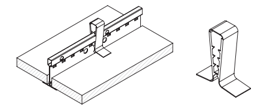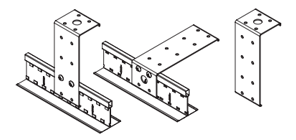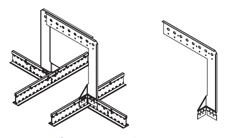Many options are available to you when it comes to ceiling installation. But how to distinguish an accessory from something that’s part of a system? Let us help.
What Is an Accessory?
An accessory is generally defined as a component that complements a system but isn’t essential for its basic function. A part, on the other hand, is required to complete the system. For example, a cross tee is a part of a ceiling system, as it’s crucial to the structure. Accessories, such as hold-down clips or seismic clips, are optional but can enhance a system’s performance or safety. While a 2” wall angle is the standard for a seismic ceiling, 7/8" Wall Angle with Seismic perimeter clips has become the new normal. Another example is hold-down clips which can be replaced with heavier panels. Accessories often provide added benefits without being necessary for a system's basic functionality.
Angle Bracket

Why Do Manufacturers Create Accessories?
Accessories exist for one of two reasons: to complement the ceiling system or to ensure its integrity. Depending on the situation, accessories can be categorized as either “nice to have” or “must-have.” Some improve efficiency, while others may seem to slow the process. It is essential to educate installers on the benefits of these accessories, as this could save valuable time and effort on the job. Installers may come up with their own workarounds, but understanding the purpose of accessories can lead to installations that are more efficient and less stressful. In general, all accessories are intended to make the installer’s job easier and ensure the ceiling functions as intended.
When and Where Are Accessories Required?
The use of accessories may be dictated by code officials or architects, project managers, or it may stem from specific technical training. Ideally, accessories should always be considered in the installation process, as they are designed to optimize system performance. While there may be exceptional cases where an accessory is unavailable or unsuitable, those recommended by manufacturers should always be your first choice.
When evaluating accessories, it’s useful to consider whether they are system-specific or general-purpose components. For example, the LBRC (L-angle bracket) is a versatile accessory that can be used in various applications, such as securing cross tees or aligning main runners at the wall angle. On the other hand, clips like the B30, B45, B60, and B90 serve more specific roles, such as maintaining the correct angle at changes in direction. While these clips can be adapted for other uses, they are best suited for inside corners. Using them in outside corners—where a simple framing screw would suffice—may result in material buildup and inefficiencies.
A Special Case
Hold-down clips were originally designed to secure panels in place during a fire, helping the ceiling system to stay intact long enough to provide time for evacuation. However, the use of fire-rated ceilings with acoustical panels has become less common. Historically used in the 1960s and 1970s as the primary fire barrier, these clips can cause issues when ceiling access is required, as they are difficult to re-engage once removed. This can compromise the integrity of the system. Today, hold-down clips are mainly used to prevent minor wind uplift, such as in vestibule applications, or when stabilization is needed during installation.
Hold Down Clip

Ecophon Accessories: Specific and Required
Ecophon ceiling systems, in contrast, often involve precise accessories designed for specific systems. At CertainTeed, we emphasize the necessity of understanding the specific system being installed. It is the responsibility of the installing contractor to ensure they have the appropriate quantity of accessories based on the size and shape of the project. CertainTeed encourages installers to thoroughly evaluate and order the necessary accessories. Many Ecophon accessories have no alternative methods for installation, leading some to question whether these should be considered accessories or integral system components. This is an important distinction, as these accessories are often essential for system performance.
Drywall Grid and the QuickSpan System: Parts vs. Accessories
When evaluating the QuickSpan Locking Drywall Suspension System, parts like the support clip should be considered system components, not accessories. These pieces are required under tested assemblies and must be used when specified. There are no exceptions. However, accessories like the Splice Clip and Direct Fixing Bracket (DFB) provide flexible solutions to common installation challenges.
- The Splice Clip is ideal for creating indexed curves in suspension systems. It's compact, strong, and easy to use, making it a popular choice among installers.
- The DFB is particularly useful when there is limited vertical space between the ceiling and the structure above, as it simplifies the process of securing the suspension system without the hassle of wire ties.
Splice Clip

Direct Fixing Bracket

A Game-Changer
The innovative SmartFit Yoke offers unparalleled flexibility for creating structurally sound openings for linear lights and diffusers while maintaining the integrity of the ceiling system. Historically, contractors would use makeshift methods to create these openings, often leading to misalignment and inefficiencies. The SmartFit Yoke solves this issue by securely connecting to a single hanger and providing a continuous slot for precise positioning. This accessory not only saves valuable installation time but also reduces the risk of damage from other trades working in the ceiling.
The Value of Accessories
Ultimately, understanding the role of ceiling accessories can significantly improve the profitability and efficiency of your projects. At CertainTeed Ceilings, we don’t design accessories for our own benefit; we create them to enhance your installation process. By carefully selecting and properly utilizing the right accessories, you can ensure a smoother, more effective installation, and elevate the overall performance of your ceiling system.
SmartFit Yoke







